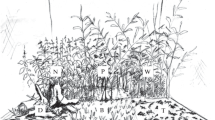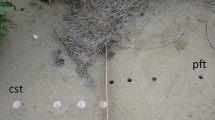Abstract
The relative effects of foraging benefits (food intake) and costs (disturbance = pit destruction) on growth rate and foraging behavior of larvae of the ant-lionMyrmeleon mobilis were investigated. In a laboratory experiment second-instar larvae were subjected to combinations of three rates of feeding and three rates of disturbance. Pit relocations were generally rare but occurred more often in starved larvae. Disturbance rate had no significant effect on pit relocation rate. Feeding rate was a major determinant of the energy allocated in pit construction and maintenance (positive relationship). In a second experiment third-instar larvae encountered changing rates of disturbance. Pit size was reduced as a response to increased rates of disturbance. Disturbance had no detectable effect on growth. In general,M. mobilis larvae were cost-conservative, foragers.
Similar content being viewed by others
References
Griffiths, D. (1980). The feeding biology of ant lion larvae: Prey capture, handling and utilization.J. Anim. Ecol. 49: 99–125.
Griffiths, D. (1986). Pit construction by ant lion larvae: A cost-benefit analysis.J. Anim. Ecol. 55: 39–57.
Griffiths, D. (1993). Intraspecific competition in ant-lion (Macroleon quinquemaculatus) larvae in the field.Oecologia 93: 531–537.
Heinrich, B., and Heinrich, M. J. E. (1984). The pit-trapping foraging strategy of the ant lion,Myrmeleon immaculatus DeGeer (Neuroptera: Myrmeleontidae).Behav. Ecol. Sociobiol. 14: 151–160.
Lucas, J. R. (1982). The biophysics of pit construction by ant lion larvae (Myrmeleon, Neuroptera).Anim. Behav. 30: 651–664.
Lucas, J. R., and Stange, L. A. (1981). Key and description to theMyrmeleon larvae of Florida (Neuroptera: Myrmeleontidae).Fla. Entomol. 64(2): 207–216.
Matsura, T. (1987). An experimental study on the foraging behavior of a pit-building antlion larva,Myrmeleon bore.Res. Popul. Ecol. 29: 17–26.
Matsura, T., and Murao, T. (1994). Comparative study on the behavioral response to starvation in three species of antlion larvae (Neuroptera: Myrmeleontidae).J. Insect Behav. 7(6): 873–884.
McClure, M. S. (1976). Spatial distribution of pit-making ant lion larvae (Neuroptera: Myrmeleontidae): Density effects.Biotropica 8: 179–183.
Olive, C. W. (1982). Behavioral response of a sit-and-wait predator to spatial variation in foraging gain.Ecology 63(4): 912–920.
Pyke, G. H. (1984). Optimal foraging theory: A critical review.Annu. Rev. Ecol. Syst. 15: 523–575.
Real, L. A., and Caraco, T. (1986). Risk and foraging in stochastic environments.Annu. Rev. Ecol. Syst. 17: 371–390.
Stephens, D. W., and Krebs, J. R. (1986).Foraging Theory, Princeton University Press, Princeton, NJ.
Townsend, C. R., and Hildrew, A. G. (1980). Foraging in a patchy environment by a predatory net-spinning caddis larvae: A test of optimal foraging theory.Oecologia 47: 219–221.
Tuculescu, R., Topoff, H., and Wolfe, S. (1975). Mechanisms of pit construction by antlion larvae.Ann. Entomol. Soc. Am. 68: 719–720.
Wilson, S. W. (1974). Prey capture and competition in the antlion.Biotropica 6(3): 187–193.
Author information
Authors and Affiliations
Rights and permissions
About this article
Cite this article
Eltz, T. Foraging in the ant-lionMyrmeleon mobilis hagen 1888 (neuroptera: Myrmeleontidae): Behavioral flexibility of a sit-and-wait predator. J Insect Behav 10, 1–11 (1997). https://doi.org/10.1007/BF02765471
Received:
Revised:
Issue Date:
DOI: https://doi.org/10.1007/BF02765471




